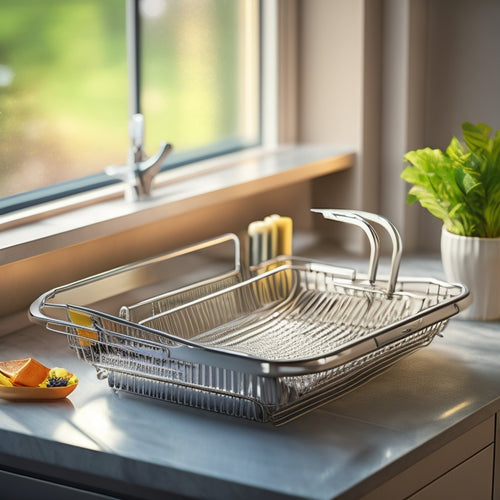
Mastering Three-Month Food Stockpiling Strategy
Share
Mastering a three-month food stockpiling strategy requires a thoughtful approach to secure a consistent supply of staple ingredients and minimize food waste. Begin by identifying your household's regular food consumption and conducting meal planning for staple ingredients. Implement accurate inventory tracking and prioritize purchases based on consumption patterns. Utilize digital and printable tools to maintain inventory tracking, plan meals efficiently, and optimize storage space. By strategizing purchases through bulk buying, couponing, and tracking sales cycles, you can minimize waste and save money. As you move forward, you'll discover the importance of regularly reviewing and replenishing your stockpile to secure food security during emergencies.
Key Takeaways
• Identify your household's regular food consumption to determine the right stockpile quantities for a three-month supply.
• Conduct meal planning to ensure staple ingredients are covered, and implement accurate inventory tracking to avoid waste and overstocking.
• Prioritize purchases based on consumption patterns, focusing on non-perishable essentials and bulk buys that align with your meal plan.
• Utilize digital and printable tools to maintain accurate inventory tracking, optimize storage space, and identify replenishment and rotation needs.
• Analyze your pantry and existing stockpile, categorizing items by expiration dates, and adjust your meal planning strategy to ensure a cohesive three-month stockpile.
Planning Your Food Supply
When building a three-month food supply, a fundamental first step is to identify the foods your household consumes regularly. This will form the foundation of your stockpile. This involves meal planning, where you determine the staple ingredients and quantities needed to sustain your household for an extended period.
Accurate inventory tracking is also vital to make sure you're not overstocking or understocking essential items. By monitoring your consumption patterns, you can prioritize purchases and optimize your stockpile.
A well-planned food supply not only saves you money but also provides peace of mind in times of uncertainty. By taking the time to plan and track your inventory, you'll be better equipped to navigate emergencies and guarantee your household's food security.
Tools for Stockpile Management
To effectively manage your three-month food stockpile, utilizing a combination of digital and printable tools is essential for maintaining accurate inventory tracking, meal planning, and optimizing storage space.
Digital tools like Excel worksheets can help you track inventory and plan meals, while printable forms provide an alternative for those without Excel. Using these tools, you can efficiently organize your stockpile, ensuring that you have a clear picture of what you have in storage.
This enables you to identify what needs to be replenished and rotated, ensuring that your stockpile remains fresh and usable. By implementing these tools, you can optimize your stockpile organization, making it easier to maintain and access the food you need in case of an emergency.
Strategizing Your Purchases
By adopting a strategic approach to purchasing, you can significantly minimize costs and maximize the value of your three-month food stockpile. A well-planned purchasing strategy ensures you're purchasing the right items at the right time, reducing waste and saving money. Here are some essential tactics to contemplate:
-
Bulk buying: Purchase items in bulk during sales to stock up on non-perishable essentials, reducing your overall cost per unit.
-
Coupon stacking: Combine manufacturer coupons with store sales to maximize your savings on the items you need.
-
Sale cycling: Keep track of sales cycles for your favorite items and plan your purchases accordingly, ensuring you're always buying at the lowest price.
Valuable Resources for Success
Equipped with the right tools and resources, you can efficiently plan and maintain your three-month food stockpile, guaranteeing a seamless emergency preparedness strategy. To maximize your efforts, utilize valuable resources such as Excel worksheets, tutorial videos, and printable forms to track your inventory and meal plans.
Additionally, explore helpful products like Deals To Meals, a service that finds grocery discounts, and 'Food Storage Made Easy,' a book that provides checklists, encyclopedia, and recipes for building food storage efficiently. Don't forget to take advantage of free downloads, including an emergency preparedness plan, 3-month supply planning sheets, and a long-term storage calculator.
Putting Your Plan Into Action
With a solid plan in place, the next crucial step is to execute it, starting with a thorough analysis of your pantry and existing stockpile to identify gaps and areas for improvement. This involves organizing your inventory, categorizing items by expiration dates, and checking for spoilage.
-
Assess your meal planning strategies to align with your stockpile, and make adjustments as needed.
-
Create a shopping list to fill the gaps in your stockpile, prioritizing essential items.
-
Set a schedule to regularly review and replenish your stockpile, making sure it remains relevant and effective.
Frequently Asked Questions
How Do I Maintain Food Quality and Freshness During Storage?
'Maintaining food quality and freshness during storage requires vigilant food rotation and proper storage techniques, such as cool, dry environments and airtight containers, as well as employing preservation methods like canning, freezing, and dehydrating to guarantee peak shelf life.'
What if I Have Limited Space for My Three-Month Supply?
When faced with limited space for your three-month supply, employ creative storage solutions such as vertical shelving and compact containers, and implement rotation techniques to guarantee oldest items are consumed first, maintaining freshness and quality.
Can I Stockpile Food for Special Dietary Needs or Restrictions?
When stockpiling food for special dietary needs, consider gluten-free options, vegan alternatives, low-sodium, and diabetic-friendly choices to guarantee a safe and healthy supply, catering to individual requirements and restrictions.
How Often Should I Inspect and Update My Emergency Food Supply?
Regularly inspect your emergency food supply every 3-6 months to check storage conditions are ideal, rotate stock according to expiration dates, and update your rotation schedule to maintain a fresh and usable supply.
Is It Necessary to Stockpile Water and Other Beverages Too?
'Did you know that 63% of Americans have less than a 3-day supply of water in their homes? Stockpiling water, along with beverage alternatives like powdered milk and juice, is vital for emergency preparedness, ensuring hydration and nutrition during crisis situations.'
Related Posts
-

Space-Saving Kitchen Island Storage Hacks
You can change your small kitchen into a functional haven with clever space-saving island storage hacks. Start by ins...
-

Rust-Resistant Dish Drainers for Long-Lasting Use
If you're looking for rust-resistant dish drainers, focus on materials like high-grade stainless steel for superior c...
-

Countertop Storage Ideas for Small Kitchens
If you're looking to maximize your small kitchen, creative countertop storage solutions can make a big difference. Em...


